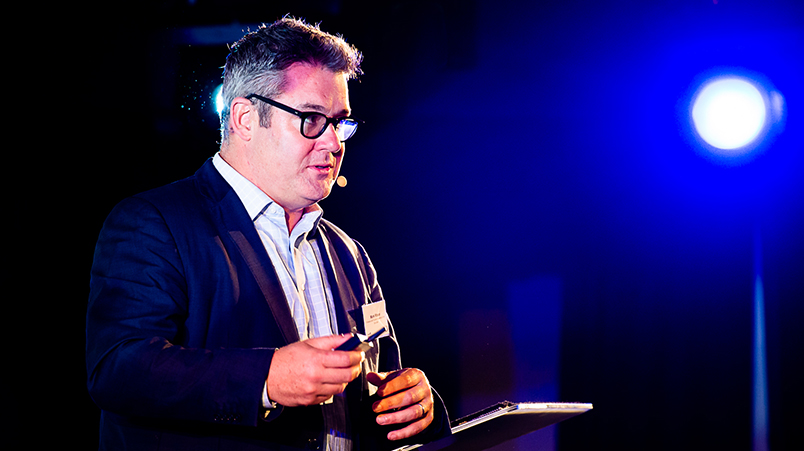P&G CMO Marc Pritchard tells marketers to get back to basics but Analytic Partners, Jellyfish say platforms have broken ad fatigue, attention rules
An Mi3 editorial series brought to you by
QMS


An Mi3 editorial series brought to you by
QMS

Procter & Gamble CMO Marc Pritchard delivered an unapologetic brand building 101 at Cannes, urging marketers to get off the "content hamster wheel" and get back to basics on craft, consistency and consumer insight, or watch growth tank. But Analytic Partners and Jellyfish presented counter-evidence that suggests the old marketing rules around attention and wear-out may no longer apply in a platform dominated world, requiring a rethink of some key effectiveness fundamentals.
The best an ad can get?
P&G CMO Marc Pritchard countered emerging marketing fault lines at Cannes this week, delivering an unapologetic back to basics brand building 101 to a hall packed with marketers and agencies.
Ad effectiveness expert Grace Kite, VP at Analytic Partners, and Jellyfish Brand Strategy VP Tom Roach had earlier unpacked research calling into question the need to capture sustained levels of attention to build brand amid spiralling channel fragmentation.
While Amplified Intelligence boss Dr, Karen Nelson-Field has consistently pointed out that 85 per cent of ads on digital platforms don’t get enough attention to create memories, Kite cited a Havas Media Network and Lumen report, ‘Aggregate Attention’, that suggests otherwise.
“What it showed is that seeing lots of little ads is a perfectly good substitute for lack of attention on any one ad,” per Kite. “It works for brand building, and it works for sales.” She cited Meta research across its platforms which drew a similar conclusion. “What they saw is you actually get more sales if you aggregate moments versus continuous moments – and it does work for sales, even if you are below that 2.5 seconds attention threshold, as long as they were working together in an aggregated way.”
Kite and Roach also urged marketers to rethink ad wear-out in an age of platform algorithms that reward new content with greater reach, and to therefore create greater volumes of fresh content that keep feeding those channels.
“All of the [marketing effectiveness] evidence says advertising wear out does not exist … but we’ve got a problem, because what the data and effectiveness theories tend to say doesn’t really fit with what the increasingly powerful platforms tell us we need to do, and tell us what their algorithms want from us as creative people,” said Roach.
But Pritchard had a different view: “Don’t get lured into the content hamster wheel. Stay in love with the craft of advertising,” he said. “That is our job [to use] creativity to compel people to turn towards our brands by attracting attention, informing, persuading, making them laugh, cry … feel… and ultimately take action, like buy. That requires art, science ideas and craft that is nurtured and revered.”
Content missteps
Digital content “has hijacked” advertising’s role, per Pritchard. “We can’t seem to get enough of it. It’s easy to produce, and we try to catch the algorithm as much as we can. But that simply accelerates the hamster wheel of content activity, all too often devoid of craft. Consumers deserve our highest level of advertising craft, wherever and whenever our brands are expressed.”
He used P&G’s Japanese skincare brand SK-II as an example of brands falling into the content trap. “It veered into activity that was entertaining and fun, but no longer reflected the preciousness of the brand,” said Pritchard. Growth suffered, leading to a rethink. “The brand is now building itself with the highest level of craftsmanship, wherever it is experienced – in stores, online, events, packaging, with influencers, creators and long form advertising… As soon as they [reversed tack], double digit growth.”
Staying power
Nodding to the work of Ehrenberg-Bass and Prof. Byron Sharp on the need to build mental availability for brands while ensuring physical availability of product, Pritchard suggested “building memory requires attention for 10-30 seconds or more to encode important information about the brand … Advertising campaigns are a proven way to build memory and I’m talking about long-term brand campaigns, not short-term media buying campaigns”.
While Sharp takes a different view on how much attention is required to make advertising work (“most exposures are fleeting … and that’s okay”), he would likely agree with Pritchard on consistency and ad wear-out (“if you're changing things, they just don't see you and they don't care”).
“All too often we change [creative] because we believe campaigns wear out,” said Pritchard. “It’s actually the opposite. Repetition is needed for ideas to wear in to build and reinforce memory… consumers don’t get tired of campaigns. In fact, repetition and consistency is required to stand out and be remembered among all the clutter.”
Brand building 101, digested
Pritchard doubled down on marketers getting back to basics with a six-point checklist that he suggested remains constant despite massive changes in how media is distributed, surfaced and consumed:
- “Know your customers better than anyone."
- “Find the insights that matter."
- “Know your brand better than anyone – the fruits are in the roots."
- “Consumers deserve our finest craft, wherever and whenever the brand is expressed.”
- “Build memory with advertising.”
- “Build enduring creative relationships – it’s the key to building the best creative work.”
Ultimately, Pritchard said David Ogilvy’s most astute observation endures: “He said ‘clients get the advertising they deserve’, and I’ve always taken that to heart.”




